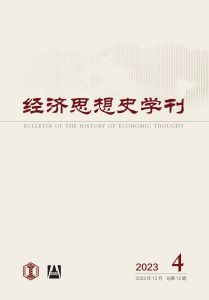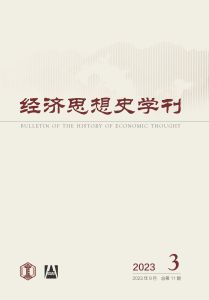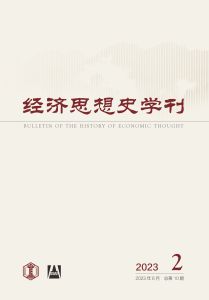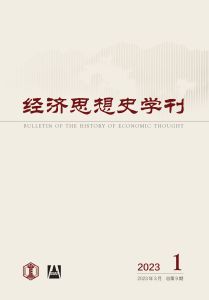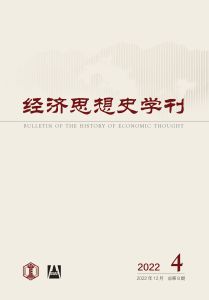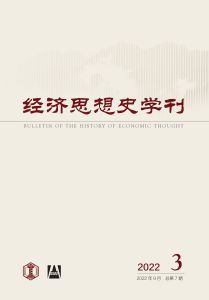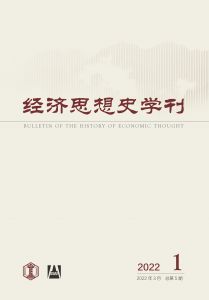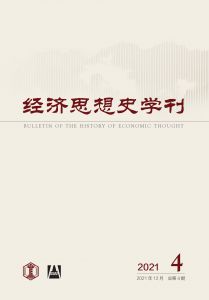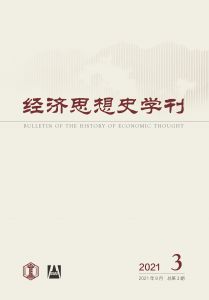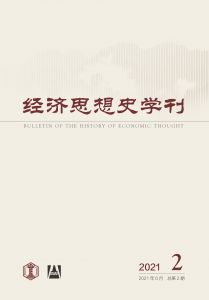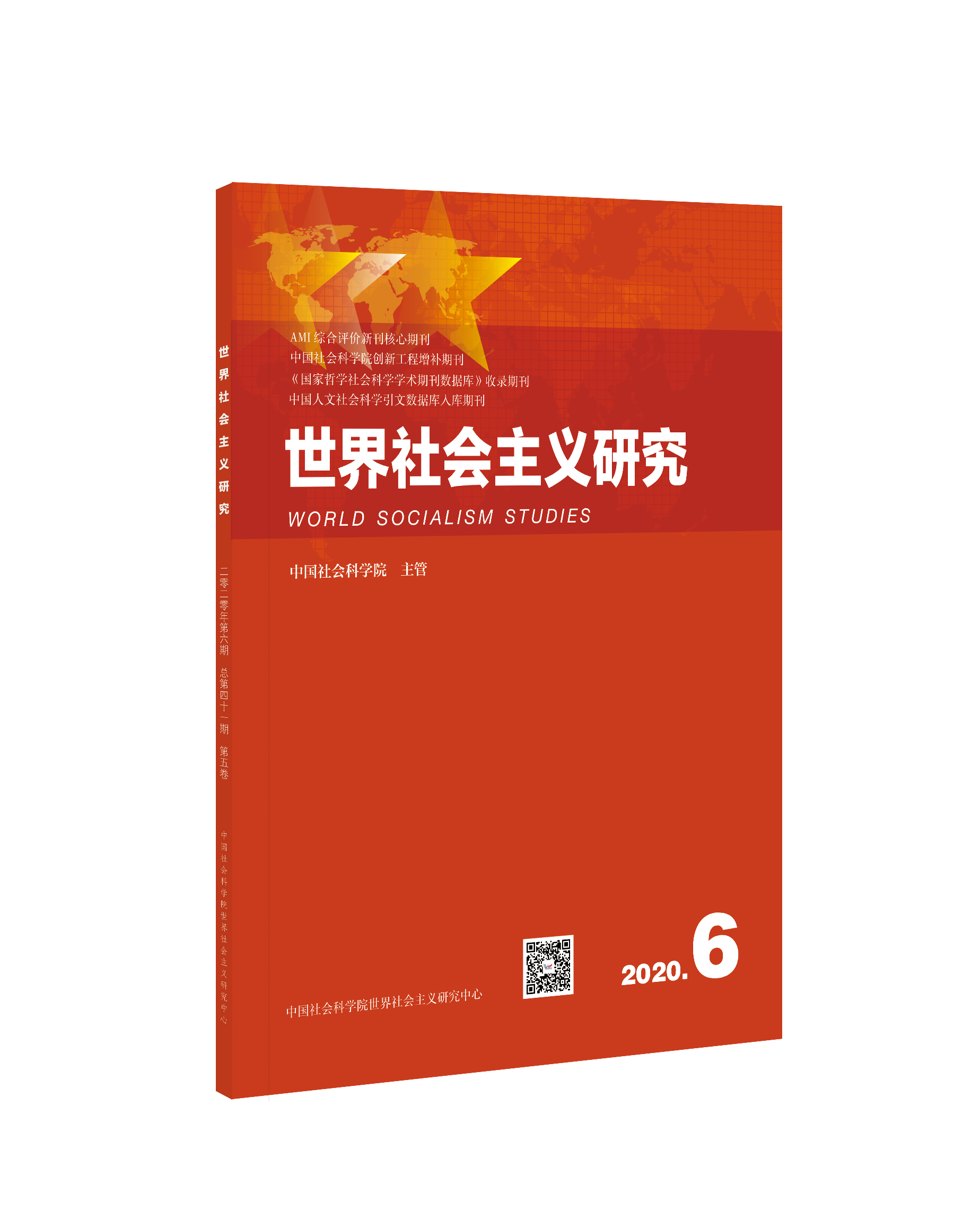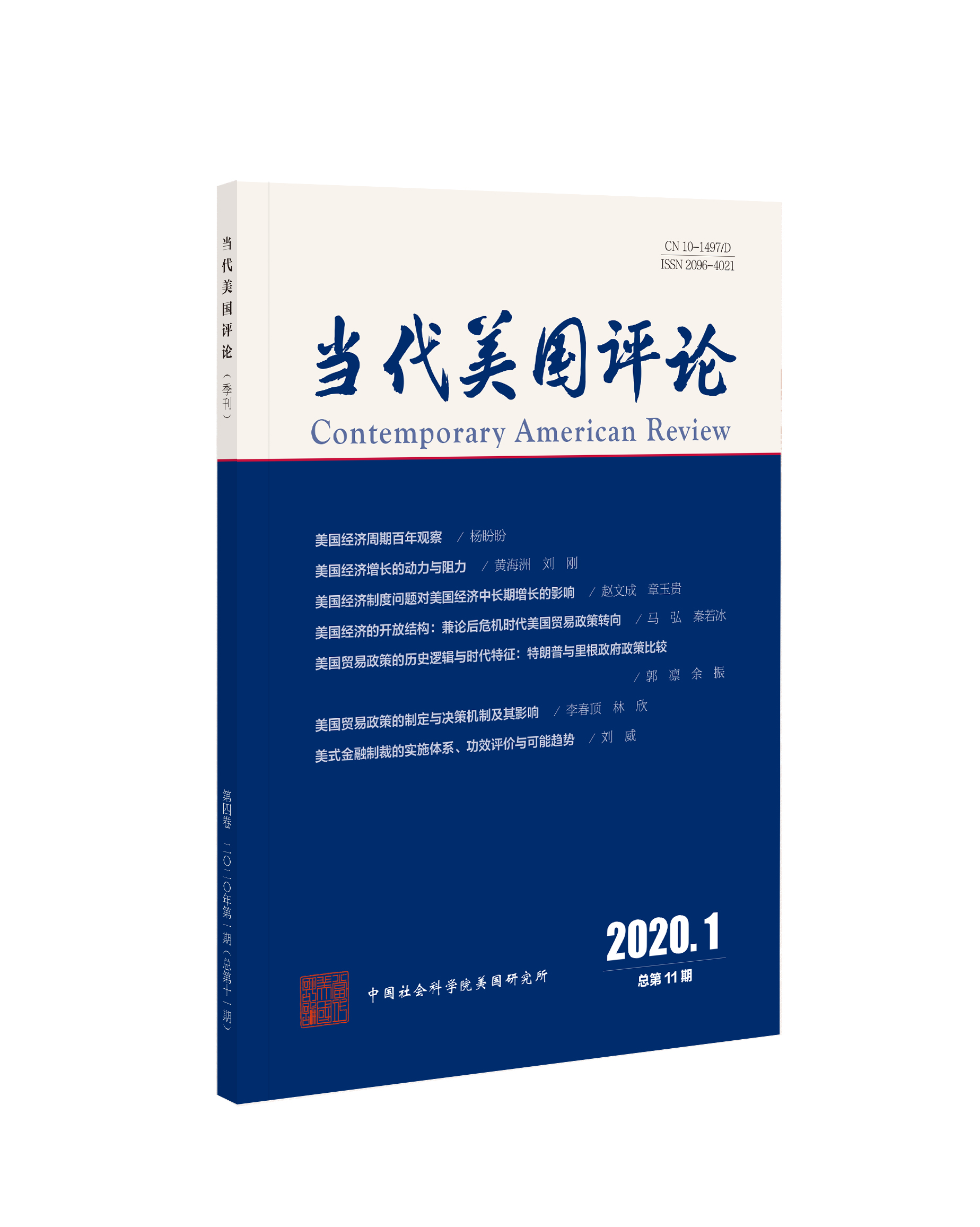最新期刊
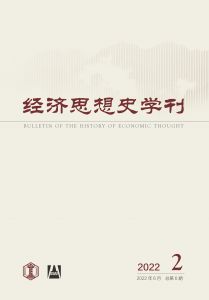
目录
过往期刊
参考文献
-
编辑委员会
-
解读“凯恩斯悖论”——关于生产率分享的思考
-
一、引言
-
二、回到未来:凯恩斯说对了什么?
-
三、合并悖论之间的同类项
-
四、生产率的提高与分享
-
五、社会福利作为最高层次的分享
-
六、趋势展望和政策涵义
-
-
进口贸易开放与产业转型升级:经济思想史的考察
-
一、古典经济学的争论:从斯密到马克思
-
二、发展经济学的进展:现代幼稚产业论
-
三、现代幼稚产业论的实践:进口替代战略
-
四、经济增长理论的探索:知识生产的视角
-
五、现代贸易理论的梳理:异质性视角的突破
-
六、结束语
-
-
技术选择的逻辑:以蒸汽机崛起为例
-
一、蒸汽机的崛起:基于“稀缺范式”的阐释
-
二、马尔姆的质疑:基于蒸汽动力与水力的比较分析
-
三、蒸汽机的崛起:基于“资本逻辑范式”的阐释
-
四、简要的评析
-
-
再论重商主义经济思想的理论内涵:从历史标签到原始文献
-
一、关于重商主义的争论与问题的提出
-
二、“重商主义”历史标签的产生及演变
-
三、重商主义经济学说的起源
-
四、重商主义理论内涵的三层次分析
-
五、结论与启示
-
-
“由外而内”:晚清外债善恶之辩到内债思想萌生发端
-
一、救国还是害国:晚清外债二重属性之辩
-
二、购债报国:内债思想萌生的学理逻辑
-
三、新型苛捐:债信、金融网络与内债践行悖论
-
四、余论
-
-
经济思想史视阈下的资本
-
各经济思想流派对资本的定义以及经济思想史上对资本认识的变化
-
对资本特性和资本行为规律的解释
-
对社会主义市场经济条件下资本的行为规律的认识
-
按年份浏览:
- 全部
- 2023
- 2022
- 2021
[1][1]戴蒙德,贾雷德,2022,《枪炮、病菌与钢铁:人类社会的命运》,王道还、廖月娟译,中信出版社。
[2][2]福格尔,罗伯特·威廉,2003,《第四次大觉醒及平等主义的未来》,王中华、刘红译,首都经济贸易大学出版社。
[3][3]戈登,罗伯特,2018,《美国增长的起落》,张林山、刘现伟、孙凤仪等译,中信出版集团。
[4][4]加尔布雷思,约翰·肯尼思,2009,《富裕社会》,赵勇、周定瑛、舒小昀译,江苏人民出版社。
[5][5]克拉克,科林,2013,《发展经济学的早期年代》,载吉拉德·M.米耶、都德莱·西尔斯编《经济发展理论的十位大师》,刘鹤等译,中国经济出版社。
[6][6]库兹涅茨,西蒙,1985,《各国的经济增长:总产值和生产结构》,常勋等译,商务印书馆。
[7][7]拉詹,拉古拉迈,2011,《断层线——全球经济潜在的危机》,刘念等译,中信出版社。
[8][8]马克思,2015,《哥达纲领批判》,中共中央马克思恩格斯列宁斯大林著作编译局编译,人民出版社。
[9][9]马克思、恩格斯,1960,《马克思恩格斯全集》第3卷,中共中央马克思恩格斯列宁斯大林著作编译局译,人民出版社。
[10][10]马克思、恩格斯,1995,《马克思恩格斯选集》第3卷,中共中央马克思恩格斯列宁斯大林著作编译局编译,人民出版社。
[11][11]麦迪森,安格斯,2003,《世界经济千年史》,伍晓鹰等译,北京大学出版社。
[12][12]皮凯蒂,托马斯,2014,《21世纪资本论》,巴曙松等译,中信出版社。
[13][13]斯基德尔斯基,罗伯特,2006,《凯恩斯传》,相蓝欣、储英译,生活·读书·新知三联书店。
[14][14]泽拉兹尼,罗杰,2011,《趁生命气息逗留》,李克勤等译,四川科学技术出版社。
[15][15]Acemoglu,Daron,David Autor,David Dorn,Gordon H.Hanson,and Brendan Price. 2014. “Return of the Solow Paradox?IT,Productivity,and Employment in U.S.Manufacturing.” NBER Working Paper No.19837.
[16][16]Aoki,Masahiko. 2012. “The Five Phases of Economic Development and Institutional Evolution in China,Japan,and Korea.” In Institutions and Comparative Economic Development ,edited by Masahiko Aoki,Timur Kuran,and Gérard Roland,pp.13-47. Basingstoke,Hampshire/New York,NY:Palgrave Macmillan.
[17][17]Brynjolfsson,Erik,and Andrew McAfee. 2011. Race Against the Machine:How the Digital Revolution is Accelerating Innovation,Driving Productivity,and Irreversibly Transforming Employment and the Economy . Lexington,Massachusetts:Digital Frontier Press.
[18][18]Cowen,Tyler. 2011. The Great Stagnation:How America Ate All the Low-Hanging Fruit of Modern History,Got Sick,and Will(Eventually)Feel Better . New York:Dutton.
[19][19]Fabo,Brian,Martina Jancoková,Elisabeth Kempf,and Luboš Pástor. 2020. “Fifty Shades of QE:Comparing Findings of Central Bankers and Academics.” NBER Working Paper No.27849.
[20][20]Foster,Lucia,John Haltiwanger,and C.J.Krizan. 1998. “Aggregate Productivity Growth:Lessons from Microeconomic Evidence.” NBER Working Paper No.6803.
[21][21]Hansen,Alvin. 2004. “On Economic Progress and Declining Population Growth.” Population and Development Review 30(2):329-342.
[22][22]Heilbrun,James. 2011. “Baumol’s Cost Disease.” In A Handbook of Cultural Economics ,edited by Ruth Towse,pp.67-75. Cheltenham,UK/Northampton,MA:Edward Elgar Publishing Limited.
[23][23]Keynes,John Maynard. 1978. “Some Economic Consequences of a Declining Population.” Population and Development Review 4(3):517-523.
[24][24]Keynes,John Maynard. 2010. “Economic Possibilities for Our Grandchildren.” In Essays in Persuasion ,pp.321-332. Basingstoke,Hampshire/New York,NY:Palgrave Macmillan.
[25][25]Krueger,Dirk,and Fabrizio Perri. 2005. “Does Income Inequality Lead to Consumption Equality?Evidence and Theory.” Federal Reserve Bank of Minneapolis Research Department Staff Report No.363.
[26][26]O’Rourke,Kevin Hjortshøj. 2015. “Economic Impossibilities for Our Grandchildren?” NBER Working Paper No.21807.
[27][27]Philippon,Thomas. 2019. The Great Reversal:How America Gave Up on Free Markets . Cambridge,Massachusetts/London,England:The Belknap Press of Harvard University Press.
[28][28]Pilat,Dirk,and Chiara Criscuolo. 2018. “The Future of Productivity:What Contribution Can Digital Transformation Make?” Policy Quarterly 14(3):10-16.
[29][29]Sen,Amartya. 2021. “Marx after Kornai.” Public Choice 187(1-2):27-32.
[30][30]Shafik,Minouche. 2021. What We Owe Each Other:A New Social Contract for a Better Society . Princeton/Oxford:Princeton University Press.
[31][31]Solow,M.Robert. 1987. “We’d Better Watch Out.” The New York Times Book Review ,July 12.
[32][32]Spence,Michael,and Sandile Hlatshwayo. 2012. “The Evolving Structure of the American Economy and the Employment Challenge.” Comparative Economic Studies 54:703-738.
[33][33]Summers,Lawrence H. 2016. “The Age of Secular Stagnation:What It Is and What to Do About It.” Foreign Affairs 95(2):2-9.
[34][34]俄林,伯特尔,2008,《区际贸易与国际贸易》,逯宇铎、苏振东、李秉强译,华夏出版社。
[35][35]恩格斯,弗里德里希,1965,《保护关税制度和自由贸易》,载马克思、恩格斯《马克思恩格斯全集》第21卷,中共中央马克思恩格斯列宁斯大林著作编译局译,人民出版社。
[36][36]李斯特,弗里德里希,1961,《政治经济学的国民体系》,陈万煦译,商务印书馆。
[37][37]刘易斯,阿瑟,1983,《经济增长理论》,周师铭、沈丙杰、沈伯根译,商务印书馆。
[38][38]马克思,卡尔,1963,《资本论》第1卷,郭大力、王亚南译,人民出版社。
[39][39]马克思,卡尔,1972,《关于自由贸易问题的演说》,载马克思、恩格斯《马克思恩格斯选集》第1卷,中共中央马克思恩格斯列宁斯大林著作编译局编,人民出版社。
[40][40]穆勒,约翰·斯图亚特,2009,《政治经济学原理》(下),金镝、金熠译,华夏出版社。
[41][41]普雷维什,劳尔,2015,《外围资本主义——危机与改造》,苏振兴、袁兴昌译,商务印书馆。
[42][42]斯密,亚当,1974,《国民财富的性质和原因的研究》(下),郭大力、王亚南译,商务印书馆。
[43][43]苏振兴、张勇,2011,《拉美经济增长方式转变与现代化进程的曲折性》,《拉丁美洲研究》第5期。
[44][44]Aghion,Philippe,and Peter Howitt. 1992. “A Model of Growth through Creative Destruction.” Econometrica 60(2):323-351.
[45][45]Amiti,Mary,and Jozef Konings. 2007. “Trade Liberalization,Intermediate Inputs,and Productivity:Evidence from Indonesia.” The American Economic Review 97(5):1611-1638.
[46][46]Bayoumi,Tamin,David T.Coe,and Elhanan Helpman. 1999. “R&D Spillovers and Global Growth.” Journal of International Economics 47(2):399-428.
[47][47]Bernard,Andrew B.,and J.Bradford Jensen. 1999. “Exceptional Exporter Performance:Cause,Effect,or Both?” Journal of International Economics 47(1):1-25.
[48][48]Bernard,Andrew B.,J.Bradford Jensen,and Robert Z.Lawrence. 1995. “Exporters,Jobs,and Wages in U.S. Manufacturing:1976-1987.” Brookings Papers on Economic Activity. Microeconomics 1995:67-119.
[49][49]Bernard,Andrew B.,Jonathan Eaton,J.Bradford Jensen,and Samuel Kortum. 2003. “Plants and Productivity in International Trade.” The American Economic Review 93(4):1268-1290.
[50][50]Bond,Eric W. 1993. “Capital Market Imperfections and the Infant Industry Argument for Protection.” In Theory,Policy and Dynamics in International Trade:Essays in Honor of Ronald W.Jones ,edited by Wilfred J.Ethier,Elhanan Helpman,and J.Peter Neary,pp.191-212. Cambridge,UK/New York:Cambridge University Press.
[51][51]Bustos,Paula. 2011. “Trade Liberalization,Exports,and Technology Upgrading:Evidence on the Impact of MERCOSUR on Argentinian Firms.” The American Economic Review 101(1):304-340.
[52][52]Coe,David T.,and Elhanan Helpman. 1995. “International R&D Spillovers.” European Economic Review 39:859-887.
[53][53]Coe,David T.,Elhanan Helpman,and Alexander W.Hoffmaister. 1997. “North-South R&D Spillovers.” The Economic Journal 107(440):134-149.
[54][54]Corden,W.Max. 1971. The Theory of Protection . Oxford:Clarendon Press.
[55][55]Corden,W.Max. 1974. Trade Policy and Economic Welfare . Oxford:Clarendon Press.
[56][56]Dinopoulos,Elias,and Paul Segerstrom. 1999. “A Schumpeterian Model of Protection and Relative Wages.” The American Economic Review 89(3):450-472.
[57][57]Dornbusch,Rudiger. 1992. “The Case for Trade Liberalization in Developing Countries.” The Journal of Economic Perspectives 6(1):69-85.
[58][58]Eaton,Jonathan,and Samuel Kortum. 1999. “International Technology Diffusion:Theory and Measurement.” International Economic Review 40(3):537-570.
[59][59]Feenstra,Robert C. 1996. “Trade and Uneven Growth.” Journal of Development Economics 49(1):229-256.
[60][60]Flam,Harry,and Robert W. Staiger. 1991. “Adverse Selection in Credit Markets and Infant Industry Protection.” In International Trade and Trade Policy ,edited by Elhanan Helpman,and Assaf Razin,pp.96-117. Cambridge,MA:The MIT Press.
[61][61]Fracasso,Andrea,and Giuseppe Vittucci Marzetti. 2015. “International Trade and R&D Spillovers.” Journal of International Economics 96(1):138-149.
[62][62]Grossman,Gene M.,and Elhanan Helpman. 1991. Innovation and Growth in the Global Economy . Cambridge,Massachusetts/London,England:The MIT Press.
[63][63]Grossman,Gene M.,and Henrik Horn. 1988. “Infant-Industry Protection Reconsidered:The Case of Informational Barriers to Entry.” The Quarterly Journal of Economics 103(4):767-788.
[64][64]Harris,Richard,Ian Keay,and Frank Lewis. 2015. “Protecting Infant Industries:Canadian Manufacturing and the National Policy,1870-1913.” Explorations in Economic History 56:15-31.
[65][65]Head,Keith. 1994. “Infant Industry Protection in the Steel Rail Industry.” Journal of International Economics 37(3-4):141-165.
[66][66]Helpman,Elhanan. 2011. Understanding Global Trade . Cambridge,Massachusetts/London,England:The Belknap Press of Harvard University Press.
[67][67]Helpman,Elhanan,and Paul R.Krugman. 1985. Market Structure and Foreign Trade:Increasing Returns,Imperfect Competition,and the International Economy . Cambridge,Massachusetts:The MIT Press.
[68][68]Hillman,Arye L.,and Peter Moser. 1996. “Trade Liberalization as Politically Optimal Exchange of Market Access.” In The New Transatlantic Economy ,edited by Matthew B.Canzoneri,Wilfred J.Ethier,and Vittorio Grilli,pp.295-312. New York:Cambridge University Press.
[69][69]Hillman,Arye L.,Ngo Van Long,and Peter Moser. 1995. “Modelling Reciprocal Trade Liberalization:The Political-economy and National-welfare Perspectives.” Swiss Journal of Economics and Statistics 131(3):503-515.
[70][70]Irwin,Douglas A. 2000. “Did Late-Nineteenth-Century U.S. Tariffs Promote Infant Industries?Evidence from the Tinplate Industry.” The Journal of Economic History 60(2):335-360.
[71][71]Jones,Charles I. 1995. “R&D-Based Models of Economic Growth.” Journal of Political Economy 103(4):759-784.
[72][72]Keller,Wolfgang. 1998. “Are International R&D Spillovers Trade-related?Analyzing Spillovers among Randomly Matched Trade Partners.” European Economic Review 42(8):1469-1481.
[73][73]Keller,Wolfgang. 2002. “Geographic Localization of International Technology Diffusion.” The American Economic Review 92(1):120-142.
[74][74]Kortum,Samuel S. 1997. “Research,Patenting,and Technological Change.” Econometrica 65(6):1389-1419.
[75][75]Krueger,Anne O. 1991. “Industrial Development and Liberalization.” In Liberalization in the Process of Economic Development ,edited by Lawrence B.Krause,and Kim Kihwan,pp.27-58. Berkeley:University of California Press.
[76][76]Lichtenberg,Frank R.,and Bruno van Pottelsberghe de la Potterie. 1998. “International R&D Spillovers:A Comment.” European Economic Review 42(8):1483-1491.
[77][77]Luzio,Eduardo,and Shane Greenstein. 1995. “Measuring the Performance of a Protected Infant Industry:The Case of Brazilian Microcomputers.” The Review of Economics and Statistics 77(4):622-633.
[78][78]Melitz,Marc J. 2003. “The Impact of Trade on Intra-Industry Reallocations and Aggregate Industry Productivity.” Econometrica 71(6):1695-1725.
[79][79]Melitz,Marc J.,and Giancarlo I.P.Ottaviano. 2008. “Market Size,Trade,and Productivity.” The Review of Economic Studies 75(1):295-316.
[80][80]Myrdal,Gunnar. 1956. An International Economy:Problems and Prospects . New York:Harper & Brothers Publishers.
[81][81]Myrdal,Gunnar. 1957. Economic Theory and Under-Developed Regions . London:Gerald Duckworth & Co.Ltd.
[82][82]Myrdal,Gunnar. 1968. Asian Drama:An Inquiry into the Poverty of Nations,Vol.2 . New York:Pantheon Books.
[83][83]Ohyama,Atsushi,Serguey Braguinsky,and Kevin M.Murphy. 2004. “Entrepreneurial Ability and Market Selection in an Infant Industry:Evidence from the Japanese Cotton Spinning Industry.” Review of Economic Dynamics 7(2):354-381.
[84][84]Pavcnik,Nina. 2002. “Trade Liberalization,Exit,and Productivity Improvement:Evidence from Chilean Plants.” The Review of Economic Studies 69(1):245-276.
[85][85]Prebisch,Raúl. 1950. The Economic Development of Latin America and Its Principal Problems . Lake Success,New York:United Nations Department of Economic Affairs.
[86][86]Prebisch,Raúl. 1954. International Co-operation in a Latin American Development Policy . New York:United Nations.
[87][87]Prebisch,Raúl. 1959a. “Commercial Policy in the Underdeveloped Countries.” The American Economic Review:Papers and Proceedings 49(2):251-273.
[88][88]Prebisch,Raúl. 1959b. “Statement at the Second Session of the Special Committee to Study the Formulation of New Measures for Economic Co-operation,of the Organization of American States.” InThe Latin American Common Market ,prepared by the Secretariat Economic Commission for Latin America,pp.141-146. New York:United Nations,Department of Economic and Soial Afffairs.
[89][89]Prebisch,Raúl. 1961a. “Joint Responsibilities for Latin American Progress.” Foreign Affairs 39(4):622-633.
[90][90]Prebisch,Raúl. 1961b. “Economic Development or Monetary Stability:The False Dilemma.” Economic Bulletin for Latin America 6(1):1-25.
[91][91]Rivera-Batiz,Luis A.,and Paul M.Romer. 1991a. “International Trade with Endogenous Technological Change.” European Economic Review 35:971-1001.
[92][92]Rivera-Batiz,Luis A.,and Paul M.Romer. 1991b. “Economic Integration and Endogenous Growth.” The Quarterly Journal of Economics 106(2):531-555.
[93][93]Romer,Paul M. 1990. “Endogenous Technological Change.” Journal of Political Economy 98(5):S71-S102.
[94][94]Segerstrom,Paul S. 1998. “Endogenous Growth without Scale Effects.” The American Economic Review 88(5):1290-1310.
[95][95]Segerstrom,Paul S.,T.C.A.Anant,and Elias Dinopoulos. 1990. “A Schumpeterian Model of the Product Life Cycle.” The American Economic Review 80(5):1077-1091.
[96][96]Singer,H.W. 1953. “Obstacles to Economic Development.” Social Research 20(1):19-31.
[97][97]Singer,H.W. 1958. “Deficit Financing of Public Capital Formation(with Special Reference to the Inflationary Process in Underdeveloped Countries).” Social and Economic Studies 7(3):85-96.
[98][98]Singer,Hans W. 1989. “Lessons of Post-War Development Experience:1945-1988.” African Development Review 1(2):1-29.
[99][99]Topalova,Petia,and Amit Khandelwal. 2011. “Trade Liberalization and Firm Productivity:The Case of India.” The Review of Economics and Statistics 93(3):995-1009.
[100][100]Tornell,Aaron. 1991. “Time Inconsistency of Protectionist Programs.” The Quarterly Journal of Economics 106(3):963-974.
[101][101]Torrens,Robert. 1970. The Budget on Commercial and Colonial Policy . New York:Augustus M.Kelley Publishers.
[102][102]Trefler,Daniel. 2004. “The Long and Short of the Canada-U.S.Free Trade Agreement.” The American Economic Review 94(4):870-895.
[103][103]Xu,Bin,and Jianmao Wang. 1999. “Capital Goods Trade and R&D Spillovers in the OECD.” The Canadian Journal of Economics 32(5):1258-1274.
[104][104]艾伦,罗伯特,2012,《近代英国工业革命揭秘:放眼全球的深度透视》,毛立坤译,浙江大学出版社。
[105][105]蔡华杰,2020,《资本逻辑宰制下的“汽车社会”意识形态透析》,《社会科学战线》第3期。
[106][106]哈维,大卫,2009,《新帝国主义》,初立忠、沈晓雷译,社会科学文献出版社。
[107][107]亨特,E.K.,2007,《经济思想史——一种批判性的视角》,颜鹏飞总译校,上海财经大学出版社。
[108][108]里格利,E.A.,2013,《延续、偶然与变迁:英国工业革命的特质》,侯琳琳译,浙江大学出版社。
[109][109]马克思、恩格斯,2009a,《马克思恩格斯文集》第1卷,中共中央马克思恩格斯列宁斯大林著作编译局编译,人民出版社。
[110][110]马克思、恩格斯,2009b,《马克思恩格斯文集》第5卷,中共中央马克思恩格斯列宁斯大林著作编译局编译,人民出版社。
[111][111]马克思、恩格斯,2009c,《马克思恩格斯文集》第8卷,中共中央马克思恩格斯列宁斯大林著作编译局编译,人民出版社。
[112][112]马克思、恩格斯,2009d,《马克思恩格斯文集》第10卷,中共中央马克思恩格斯列宁斯大林著作编译局编译,人民出版社。
[113][113]芒图,保尔,1983,《十八世纪产业革命——英国近代大工业初期的概况》,杨人楩、陈希秦、吴绪译,商务印书馆。
[114][114]彭慕兰,2010,《大分流:欧洲、中国及现代世界经济的发展》,史建云译,江苏人民出版社。
[115][115]王章辉,1996,《英国工业化与农村劳动力的转移》,《世界历史》第6期。
[116][116]Chapman,Stanley D. 1971. “The Cost of Power in the Industrial Revolution in Britain:The Case of the Textile Industry.” Midlands History 1(2):1-24.
[117][117]Freeman,Chris,and Francisco Louçã. 2001. As Time Goes by:The Information Revolution and the Industrial Revolutions in Historical Perspective . New York:Oxford University Press.
[118][118]Gordon,Robert B. 1983. “Cost and Use of Water Power during Industrialization in New England and Great Britain:A Geological Interpretation.” The Economic History Review 36(2):240-259.
[119][119]Malm,Andreas. 2013. “The Origins of Fossil Capital:From Water to Steam in the British Cotton Industry.” Historical Materialism 21(1):15-68.
[120][120]Malm,Andreas. 2016. Fossil Capital:The Rise of Steam Power and the Roots of Global Warming . London/New York:Verso.
[121][121]Shaw,John. 1984. Water Power in Scotland:1550-1870 . Edinburgh:John Donald Publishers.
[122][122]Wrigley,E.A. 2010. Energy and the English Industrial Revolution . Cambridge:Cambridge University Press.
[123][123]布劳格,马克,2009,《经济理论的回顾》,姚开建译校,中国人民大学出版社。
[124][124]达维南特,查尔斯,1995,《论英国的公共收入与贸易》,朱泱、胡企林译,商务印书馆。
[125][125]黑尔斯,约翰,2009,《略论英国政策》,载伊丽莎白·拉蒙德主编《论英国本土的公共福利》,马清槐译,商务印书馆。
[126][126]黄阳华,2020,《重商主义及其当代意义》,《学习与探索》第4期。
[127][127]贾根良,2021,《论加强经济政策史和经济政策思想史的研究》,《经济思想史学刊》第2期。
[128][128]贾根良、严鹏,2016,《重商主义与英印“大分流”——被古典经济学篡改的全球史》,《政治经济学评论》第6期。
[129][129]贾根良、张志,2016,《重商主义经济学革命:意义、贡献与现实价值》,《教学与研究》第11期。
[130][130]贾根良、张志,2017,《重商与重农:孰是孰非——基于国家富强视角的比较》,《经济学家》第2期。
[131][131]蒋自强等,2003,《经济思想通史》第1卷,浙江大学出版社。
[132][132]赖纳特,埃里克·S.、阿诺·曼·达斯特,2007,《替代性教规:文艺复兴经济学史——论以非物质和生产为基础的教规在经济思想史和经济政策史中的作用》,载埃里克·S.赖纳特、贾根良主编《穷国的富国论——演化发展经济学论文选》,贾根良、王中华等译,高等教育出版社。
[133][133]李斯特,弗里德里希,2017,《政治经济学的国民体系》,陈万煦译,商务印书馆。
[134][134]李新宽,2009,《重商主义概念辨析》,《东北师大学报(哲学社会科学版)》第4期。
[135][135]卢森贝,1959,《政治经济学史》第1卷,李侠公译,生活·读书·新知三联书店。
[136][136]鲁友章,1964,《重商主义》,商务印书馆。
[137][137]罗德里克,丹尼,2013,《新重商主义的挑战》,《南风窗》第3期。
[138][138]罗尔,埃里克,1981,《经济思想史》,陆元诚译,商务印书馆。
[139][139]马克思、恩格斯,1995,《马克思恩格斯全集》第13卷,中共中央马克思恩格斯列宁斯大林著作编译局译,人民出版社。
[140][140]马克思、恩格斯,2009a,《马克思恩格斯文集》第1卷,中共中央马克思恩格斯列宁斯大林著作编译局编译,人民出版社。
[141][141]马克思、恩格斯,2009b,《马克思恩格斯文集》第5卷,中共中央马克思恩格斯列宁斯大林著作编译局编译,人民出版社。
[142][142]马克思、恩格斯,2009c,《马克思恩格斯文集》第7卷,中共中央马克思恩格斯列宁斯大林著作编译局编译,人民出版社。
[143][143]马克思、恩格斯,2009d,《马克思恩格斯文集》第8卷,中共中央马克思恩格斯列宁斯大林著作编译局编译,人民出版社。
[144][144]马克思、恩格斯,2009e,《马克思恩格斯文集》第9卷,中共中央马克思恩格斯列宁斯大林著作编译局编译,人民出版社。
[145][145]梅俊杰,2012,《论科尔贝及其重商主义实践》,《社会科学》第12期。
[146][146]梅俊杰,2017,《重商主义真相探解》,《社会科学》第7期。
[147][147]孟,托马斯,2017a,《贸易论》,载托马斯·孟、尼古拉斯·巴尔本、达德利·诺思《贸易论(三种)》,顾为群等译,商务印书馆。
[148][148]孟,托马斯,2017b,《英国得自对外贸易的财富》,袁南宇译,商务印书馆。
[149][149]乔洪武,1998,《重商主义的经济伦理思想研究》,《经济评论》第2期。
[150][150]塞拉,安东尼奥,2017,《略论可以使无矿之国金银充裕的成因》,载A.E.门罗编《早期经济思想:亚当·斯密以前的经济文献选集》,蔡受百译,商务印书馆。
[151][151]斯密,亚当,2009,《国民财富的性质和原因的研究》(下),郭大力、王亚南译,商务印书馆。
[152][152]斯莫拉,2016,《重商制度及其历史意义》,郑学稼译,上海社会科学院出版社。
[153][153]维贝尔,马克斯,1981,《世界经济通史》,姚曾廙译,上海译文出版社。
[154][154]巫宝三,1982,《论经济思想史的研究对象、方法和意义——经济思想史研究的回顾和前景》,载巫宝三、陈振文等《经济思想史论文集》,北京大学出版社。
[155][155]巫宝三,1990,《中国经济思想史研究展望》,《经济研究》第4期。
[156][156]伍山林,2021,《如何认识经济思想的“谱系”——以英国重商主义为例》,《经济思想史学刊》第3期。
[157][157]熊彼特,约瑟夫,2009,《经济分析史》第1卷,朱泱等译,商务印书馆。
[158][158]姚开建,2011,《经济学说史》,中国人民大学出版社。
[159][159]赵修义,1999,《关于经济哲学的笔谈·经济学和哲学的内在联系》,《中国社会科学》第2期。
[160][160]Aizenman,Joshua,and Jaewoo Lee. 2007. “International Reserves:Precautionary Versus Mercantilist Views,Theory and Evidence.” Open Economies Review 18(2):191-214.
[161][161]Aizenman,Joshua,and Jaewoo Lee. 2008. “Financial Versus Monetary Mercantilism:Long-run View of the Large International Reserves Hoarding.” The World Economy 31(5):593-611.
[162][162]Bonatti,Luigi,and Andrea Fracasso. 2013. “Hoarding of International Reserves in China:Mercantilism,Domestic Consumption and US Monetary Policy.” Journal of International Money and Finance 32(2):1044-1078.
[163][163]Chu,C.Y.Cyrus,and Po-Ching Lee. 2020. “E-commerce Mercantilism-Practices and Causes.” Journal of International Trade Law and Policy 19(1):51-66.
[164][164]Coke,Roger. 1994. Treatise III:England’s Improvement . quoted from Eli F. Heckscher,Mercantilism . New York:Routledge.
[165][165]Coleman,D.C. 1957. “Eli Heckscher and the Idea of Mercantilism.” Scandinavian Economic History Review 5(1):3-25.
[166][166]Cunningham,William. 1903. The Growth of English Industry and Commerce . Cambridge:Cambridge University Press.
[167][167]De Roover,Raymond. 1955. “Scholastic Economics:Survival and Lasting Influence from the Sixteenth Century to Adam Smith.” The Quarterly Journal of Economics 69(2):161-190.
[168][168]Heaton,Herbert. 1937. “Heckscher on Mercantilism.” Journal of Political Economy 45(3):370-393.
[169][169]Heckscher,Eli F. 1936. “Revisions in Economic History:V.Mercantilism.” The Economic History Review 7(1):44-54.
[170][170]Heckscher,Eli F. 1994. Mercantilism . New York:Routledge.
[171][171]Herlitz,Lars. 1964. “The Concept of Mercantilism.” Scandinavian Economic History Review 12(2):101-120.
[172][172]Judges,A.V. 1939. “The Idea of a Mercantile State.” Transactions of the Royal Historical Society 21:41-69.
[173][173]Magnusson,Lars. 1994. Mercantilism:The Shaping of an Economic Language . London/New York:Routledge.
[174][174]Magnusson,Lars. 2015. The Political Economy of Mercantilism . London:Routledge.
[175][175]McMichael,Philip. 2013. “Land Grabbing as Security Mercantilism in International Relations.” Globalizations 10(1):47-64.
[176][176]陈锋、蔡国斌,2015,《中国财政通史》第7卷《清代财政史》(下),湖南人民出版社。
[177][177]陈秀尾,1994,《论晚清财政对洋务运动的影响》,《中国社会经济史研究》第1期。
[178][178]黄遵宪,1981,《日本杂事诗广注》,钟叔河辑校,湖南人民出版社。
[179][179]江晓成,2017,《清代的京债与地方吏治》,《清史研究》第1期。
[180][180]姜良芹,2004a,《南京国民政府1936年内债整理案述评》,《近代史研究》第1期。
[181][181]姜良芹,2004b,《试析1927—1937年国民政府内债发行的社会经济效应》,《民国档案》第4期。
[182][182]李晓、李黎明,2021,《中西金融大分流的国家信用逻辑》,《吉林大学社会科学学报》第2期。
[183][183]梁启超,1999a,《外资输入问题》,载《梁启超全集》第3册,北京出版社。
[184][184]梁启超,1999b,《外债平议》,载《梁启超全集》第4册,北京出版社。
[185][185]廖常勇,2007,《清后期国债的财政制度效应研究》,博士学位论文,西南财经大学。
[186][186]刘杰,2017,《民国时期政府内债管理制度的变迁(1914—1927年)》,《学习与实践》第6期。
[187][187]刘巍,2021,《西学中用:熊希龄财政思想与实践研究》,《福建论坛(人文社会科学版)》第1期。
[188][188]刘晓泉,2014,《国民政府地方公债管理政策述评》,《江西财经大学学报》第1期。
[189][189]罗玉东,1933,《光绪朝补救财政之方策》,《中国近代经济史研究集刊》第1卷第2期。
[190][190]马建忠,1994,《借债以开铁路说(光绪五年冬日)》,载马建忠《适可斋记言》,辽宁人民出版社。
[191][191]马金华,2011,《外债与晚清政局》,社会科学文献出版社。
[192][192]马陵合,2005,《晚清外债史研究》,复旦大学出版社。
[193][193]宓汝成,1980,《帝国主义与中国铁路(1847—1949)》,上海人民出版社。
[194][194]潘国旗,2007,《近代中国国内公债研究(1840—1926)》,经济科学出版社。
[195][195]千家驹,1933,《中国的内债》,社会调查所印行。
[196][196]杨度,1986,《粤汉铁路议(一九○五年三月)》,载刘晴波主编《杨度集》,湖南人民出版社。
[197][197]张国辉,1982,《论外国资本对洋务企业的贷款》,《历史研究》第4期。
[198][198]戴蒙德,贾雷德,2022,《枪炮、病菌与钢铁:人类社会的命运》,王道还、廖月娟译,中信出版社。
[199][199]福格尔,罗伯特·威廉,2003,《第四次大觉醒及平等主义的未来》,王中华、刘红译,首都经济贸易大学出版社。
[200][200]戈登,罗伯特,2018,《美国增长的起落》,张林山、刘现伟、孙凤仪等译,中信出版集团。
[201][201]加尔布雷思,约翰·肯尼思,2009,《富裕社会》,赵勇、周定瑛、舒小昀译,江苏人民出版社。
[202][202]克拉克,科林,2013,《发展经济学的早期年代》,载吉拉德·M.米耶、都德莱·西尔斯编《经济发展理论的十位大师》,刘鹤等译,中国经济出版社。
[203][203]库兹涅茨,西蒙,1985,《各国的经济增长:总产值和生产结构》,常勋等译,商务印书馆。
[204][204]拉詹,拉古拉迈,2011,《断层线——全球经济潜在的危机》,刘念等译,中信出版社。
[205][205]马克思,2015,《哥达纲领批判》,中共中央马克思恩格斯列宁斯大林著作编译局编译,人民出版社。
[206][206]马克思、恩格斯,1960,《马克思恩格斯全集》第3卷,中共中央马克思恩格斯列宁斯大林著作编译局译,人民出版社。
[207][207]马克思、恩格斯,1995,《马克思恩格斯选集》第3卷,中共中央马克思恩格斯列宁斯大林著作编译局编译,人民出版社。
[208][208]麦迪森,安格斯,2003,《世界经济千年史》,伍晓鹰等译,北京大学出版社。
[209][209]皮凯蒂,托马斯,2014,《21世纪资本论》,巴曙松等译,中信出版社。
[210][210]斯基德尔斯基,罗伯特,2006,《凯恩斯传》,相蓝欣、储英译,生活·读书·新知三联书店。
[211][211]泽拉兹尼,罗杰,2011,《趁生命气息逗留》,李克勤等译,四川科学技术出版社。
[212][212]Acemoglu,Daron,David Autor,David Dorn,Gordon H.Hanson,and Brendan Price. 2014. “Return of the Solow Paradox?IT,Productivity,and Employment in U.S.Manufacturing.” NBER Working Paper No.19837.
[213][213]Aoki,Masahiko. 2012. “The Five Phases of Economic Development and Institutional Evolution in China,Japan,and Korea.” In Institutions and Comparative Economic Development ,edited by Masahiko Aoki,Timur Kuran,and Gérard Roland,pp.13-47. Basingstoke,Hampshire/New York,NY:Palgrave Macmillan.
[214][214]Brynjolfsson,Erik,and Andrew McAfee. 2011. Race Against the Machine:How the Digital Revolution is Accelerating Innovation,Driving Productivity,and Irreversibly Transforming Employment and the Economy . Lexington,Massachusetts:Digital Frontier Press.
[215][215]Cowen,Tyler. 2011. The Great Stagnation:How America Ate All the Low-Hanging Fruit of Modern History,Got Sick,and Will(Eventually)Feel Better . New York:Dutton.
[216][216]Fabo,Brian,Martina Jancoková,Elisabeth Kempf,and Luboš Pástor. 2020. “Fifty Shades of QE:Comparing Findings of Central Bankers and Academics.” NBER Working Paper No.27849.
[217][217]Foster,Lucia,John Haltiwanger,and C.J.Krizan. 1998. “Aggregate Productivity Growth:Lessons from Microeconomic Evidence.” NBER Working Paper No.6803.
[218][218]Hansen,Alvin. 2004. “On Economic Progress and Declining Population Growth.” Population and Development Review 30(2):329-342.
[219][219]Heilbrun,James. 2011. “Baumol’s Cost Disease.” In A Handbook of Cultural Economics ,edited by Ruth Towse,pp.67-75. Cheltenham,UK/Northampton,MA:Edward Elgar Publishing Limited.
[220][220]Keynes,John Maynard. 1978. “Some Economic Consequences of a Declining Population.” Population and Development Review 4(3):517-523.
[221][221]Keynes,John Maynard. 2010. “Economic Possibilities for Our Grandchildren.” In Essays in Persuasion ,pp.321-332. Basingstoke,Hampshire/New York,NY:Palgrave Macmillan.
[222][222]Krueger,Dirk,and Fabrizio Perri. 2005. “Does Income Inequality Lead to Consumption Equality?Evidence and Theory.” Federal Reserve Bank of Minneapolis Research Department Staff Report No.363.
[223][223]O’Rourke,Kevin Hjortshøj. 2015. “Economic Impossibilities for Our Grandchildren?” NBER Working Paper No.21807.
[224][224]Philippon,Thomas. 2019. The Great Reversal:How America Gave Up on Free Markets . Cambridge,Massachusetts/London,England:The Belknap Press of Harvard University Press.
[225][225]Pilat,Dirk,and Chiara Criscuolo. 2018. “The Future of Productivity:What Contribution Can Digital Transformation Make?” Policy Quarterly 14(3):10-16.
[226][226]Sen,Amartya. 2021. “Marx after Kornai.” Public Choice 187(1-2):27-32.
[227][227]Shafik,Minouche. 2021. What We Owe Each Other:A New Social Contract for a Better Society . Princeton/Oxford:Princeton University Press.
[228][228]Solow,M.Robert. 1987. “We’d Better Watch Out.” The New York Times Book Review ,July 12.
[229][229]Spence,Michael,and Sandile Hlatshwayo. 2012. “The Evolving Structure of the American Economy and the Employment Challenge.” Comparative Economic Studies 54:703-738.
[230][230]Summers,Lawrence H. 2016. “The Age of Secular Stagnation:What It Is and What to Do About It.” Foreign Affairs 95(2):2-9.
[231][231]俄林,伯特尔,2008,《区际贸易与国际贸易》,逯宇铎、苏振东、李秉强译,华夏出版社。
[232][232]恩格斯,弗里德里希,1965,《保护关税制度和自由贸易》,载马克思、恩格斯《马克思恩格斯全集》第21卷,中共中央马克思恩格斯列宁斯大林著作编译局译,人民出版社。
[233][233]李斯特,弗里德里希,1961,《政治经济学的国民体系》,陈万煦译,商务印书馆。
[234][234]刘易斯,阿瑟,1983,《经济增长理论》,周师铭、沈丙杰、沈伯根译,商务印书馆。
[235][235]马克思,卡尔,1963,《资本论》第1卷,郭大力、王亚南译,人民出版社。
[236][236]马克思,卡尔,1972,《关于自由贸易问题的演说》,载马克思、恩格斯《马克思恩格斯选集》第1卷,中共中央马克思恩格斯列宁斯大林著作编译局编,人民出版社。
[237][237]穆勒,约翰·斯图亚特,2009,《政治经济学原理》(下),金镝、金熠译,华夏出版社。
[238][238]普雷维什,劳尔,2015,《外围资本主义——危机与改造》,苏振兴、袁兴昌译,商务印书馆。
[239][239]斯密,亚当,1974,《国民财富的性质和原因的研究》(下),郭大力、王亚南译,商务印书馆。
[240][240]苏振兴、张勇,2011,《拉美经济增长方式转变与现代化进程的曲折性》,《拉丁美洲研究》第5期。
[241][241]Aghion,Philippe,and Peter Howitt. 1992. “A Model of Growth through Creative Destruction.” Econometrica 60(2):323-351.
[242][242]Amiti,Mary,and Jozef Konings. 2007. “Trade Liberalization,Intermediate Inputs,and Productivity:Evidence from Indonesia.” The American Economic Review 97(5):1611-1638.
[243][243]Bayoumi,Tamin,David T.Coe,and Elhanan Helpman. 1999. “R&D Spillovers and Global Growth.” Journal of International Economics 47(2):399-428.
[244][244]Bernard,Andrew B.,and J.Bradford Jensen. 1999. “Exceptional Exporter Performance:Cause,Effect,or Both?” Journal of International Economics 47(1):1-25.
[245][245]Bernard,Andrew B.,J.Bradford Jensen,and Robert Z.Lawrence. 1995. “Exporters,Jobs,and Wages in U.S. Manufacturing:1976-1987.” Brookings Papers on Economic Activity. Microeconomics 1995:67-119.
[246][246]Bernard,Andrew B.,Jonathan Eaton,J.Bradford Jensen,and Samuel Kortum. 2003. “Plants and Productivity in International Trade.” The American Economic Review 93(4):1268-1290.
[247][247]Bond,Eric W. 1993. “Capital Market Imperfections and the Infant Industry Argument for Protection.” In Theory,Policy and Dynamics in International Trade:Essays in Honor of Ronald W.Jones ,edited by Wilfred J.Ethier,Elhanan Helpman,and J.Peter Neary,pp.191-212. Cambridge,UK/New York:Cambridge University Press.
[248][248]Bustos,Paula. 2011. “Trade Liberalization,Exports,and Technology Upgrading:Evidence on the Impact of MERCOSUR on Argentinian Firms.” The American Economic Review 101(1):304-340.
[249][249]Coe,David T.,and Elhanan Helpman. 1995. “International R&D Spillovers.” European Economic Review 39:859-887.
[250][250]Coe,David T.,Elhanan Helpman,and Alexander W.Hoffmaister. 1997. “North-South R&D Spillovers.” The Economic Journal 107(440):134-149.
[251][251]Corden,W.Max. 1971. The Theory of Protection . Oxford:Clarendon Press.
[252][252]Corden,W.Max. 1974. Trade Policy and Economic Welfare . Oxford:Clarendon Press.
[253][253]Dinopoulos,Elias,and Paul Segerstrom. 1999. “A Schumpeterian Model of Protection and Relative Wages.” The American Economic Review 89(3):450-472.
[254][254]Dornbusch,Rudiger. 1992. “The Case for Trade Liberalization in Developing Countries.” The Journal of Economic Perspectives 6(1):69-85.
[255][255]Eaton,Jonathan,and Samuel Kortum. 1999. “International Technology Diffusion:Theory and Measurement.” International Economic Review 40(3):537-570.
[256][256]Feenstra,Robert C. 1996. “Trade and Uneven Growth.” Journal of Development Economics 49(1):229-256.
[257][257]Flam,Harry,and Robert W. Staiger. 1991. “Adverse Selection in Credit Markets and Infant Industry Protection.” In International Trade and Trade Policy ,edited by Elhanan Helpman,and Assaf Razin,pp.96-117. Cambridge,MA:The MIT Press.
[258][258]Fracasso,Andrea,and Giuseppe Vittucci Marzetti. 2015. “International Trade and R&D Spillovers.” Journal of International Economics 96(1):138-149.
[259][259]Grossman,Gene M.,and Elhanan Helpman. 1991. Innovation and Growth in the Global Economy . Cambridge,Massachusetts/London,England:The MIT Press.
[260][260]Grossman,Gene M.,and Henrik Horn. 1988. “Infant-Industry Protection Reconsidered:The Case of Informational Barriers to Entry.” The Quarterly Journal of Economics 103(4):767-788.
[261][261]Harris,Richard,Ian Keay,and Frank Lewis. 2015. “Protecting Infant Industries:Canadian Manufacturing and the National Policy,1870-1913.” Explorations in Economic History 56:15-31.
[262][262]Head,Keith. 1994. “Infant Industry Protection in the Steel Rail Industry.” Journal of International Economics 37(3-4):141-165.
[263][263]Helpman,Elhanan. 2011. Understanding Global Trade . Cambridge,Massachusetts/London,England:The Belknap Press of Harvard University Press.
[264][264]Helpman,Elhanan,and Paul R.Krugman. 1985. Market Structure and Foreign Trade:Increasing Returns,Imperfect Competition,and the International Economy . Cambridge,Massachusetts:The MIT Press.
[265][265]Hillman,Arye L.,and Peter Moser. 1996. “Trade Liberalization as Politically Optimal Exchange of Market Access.” In The New Transatlantic Economy ,edited by Matthew B.Canzoneri,Wilfred J.Ethier,and Vittorio Grilli,pp.295-312. New York:Cambridge University Press.
[266][266]Hillman,Arye L.,Ngo Van Long,and Peter Moser. 1995. “Modelling Reciprocal Trade Liberalization:The Political-economy and National-welfare Perspectives.” Swiss Journal of Economics and Statistics 131(3):503-515.
[267][267]Irwin,Douglas A. 2000. “Did Late-Nineteenth-Century U.S. Tariffs Promote Infant Industries?Evidence from the Tinplate Industry.” The Journal of Economic History 60(2):335-360.
[268][268]Jones,Charles I. 1995. “R&D-Based Models of Economic Growth.” Journal of Political Economy 103(4):759-784.
[269][269]Keller,Wolfgang. 1998. “Are International R&D Spillovers Trade-related?Analyzing Spillovers among Randomly Matched Trade Partners.” European Economic Review 42(8):1469-1481.
[270][270]Keller,Wolfgang. 2002. “Geographic Localization of International Technology Diffusion.” The American Economic Review 92(1):120-142.
[271][271]Kortum,Samuel S. 1997. “Research,Patenting,and Technological Change.” Econometrica 65(6):1389-1419.
[272][272]Krueger,Anne O. 1991. “Industrial Development and Liberalization.” In Liberalization in the Process of Economic Development ,edited by Lawrence B.Krause,and Kim Kihwan,pp.27-58. Berkeley:University of California Press.
[273][273]Lichtenberg,Frank R.,and Bruno van Pottelsberghe de la Potterie. 1998. “International R&D Spillovers:A Comment.” European Economic Review 42(8):1483-1491.
[274][274]Luzio,Eduardo,and Shane Greenstein. 1995. “Measuring the Performance of a Protected Infant Industry:The Case of Brazilian Microcomputers.” The Review of Economics and Statistics 77(4):622-633.
[275][275]Melitz,Marc J. 2003. “The Impact of Trade on Intra-Industry Reallocations and Aggregate Industry Productivity.” Econometrica 71(6):1695-1725.
[276][276]Melitz,Marc J.,and Giancarlo I.P.Ottaviano. 2008. “Market Size,Trade,and Productivity.” The Review of Economic Studies 75(1):295-316.
[277][277]Myrdal,Gunnar. 1956. An International Economy:Problems and Prospects . New York:Harper & Brothers Publishers.
[278][278]Myrdal,Gunnar. 1957. Economic Theory and Under-Developed Regions . London:Gerald Duckworth & Co.Ltd.
[279][279]Myrdal,Gunnar. 1968. Asian Drama:An Inquiry into the Poverty of Nations,Vol.2 . New York:Pantheon Books.
[280][280]Ohyama,Atsushi,Serguey Braguinsky,and Kevin M.Murphy. 2004. “Entrepreneurial Ability and Market Selection in an Infant Industry:Evidence from the Japanese Cotton Spinning Industry.” Review of Economic Dynamics 7(2):354-381.
[281][281]Pavcnik,Nina. 2002. “Trade Liberalization,Exit,and Productivity Improvement:Evidence from Chilean Plants.” The Review of Economic Studies 69(1):245-276.
[282][282]Prebisch,Raúl. 1950. The Economic Development of Latin America and Its Principal Problems . Lake Success,New York:United Nations Department of Economic Affairs.
[283][283]Prebisch,Raúl. 1954. International Co-operation in a Latin American Development Policy . New York:United Nations.
[284][284]Prebisch,Raúl. 1959a. “Commercial Policy in the Underdeveloped Countries.” The American Economic Review:Papers and Proceedings 49(2):251-273.
[285][285]Prebisch,Raúl. 1959b. “Statement at the Second Session of the Special Committee to Study the Formulation of New Measures for Economic Co-operation,of the Organization of American States.” InThe Latin American Common Market ,prepared by the Secretariat Economic Commission for Latin America,pp.141-146. New York:United Nations,Department of Economic and Soial Afffairs.
[286][286]Prebisch,Raúl. 1961a. “Joint Responsibilities for Latin American Progress.” Foreign Affairs 39(4):622-633.
[287][287]Prebisch,Raúl. 1961b. “Economic Development or Monetary Stability:The False Dilemma.” Economic Bulletin for Latin America 6(1):1-25.
[288][288]Rivera-Batiz,Luis A.,and Paul M.Romer. 1991a. “International Trade with Endogenous Technological Change.” European Economic Review 35:971-1001.
[289][289]Rivera-Batiz,Luis A.,and Paul M.Romer. 1991b. “Economic Integration and Endogenous Growth.” The Quarterly Journal of Economics 106(2):531-555.
[290][290]Romer,Paul M. 1990. “Endogenous Technological Change.” Journal of Political Economy 98(5):S71-S102.
[291][291]Segerstrom,Paul S. 1998. “Endogenous Growth without Scale Effects.” The American Economic Review 88(5):1290-1310.
[292][292]Segerstrom,Paul S.,T.C.A.Anant,and Elias Dinopoulos. 1990. “A Schumpeterian Model of the Product Life Cycle.” The American Economic Review 80(5):1077-1091.
[293][293]Singer,H.W. 1953. “Obstacles to Economic Development.” Social Research 20(1):19-31.
[294][294]Singer,H.W. 1958. “Deficit Financing of Public Capital Formation(with Special Reference to the Inflationary Process in Underdeveloped Countries).” Social and Economic Studies 7(3):85-96.
[295][295]Singer,Hans W. 1989. “Lessons of Post-War Development Experience:1945-1988.” African Development Review 1(2):1-29.
[296][296]Topalova,Petia,and Amit Khandelwal. 2011. “Trade Liberalization and Firm Productivity:The Case of India.” The Review of Economics and Statistics 93(3):995-1009.
[297][297]Tornell,Aaron. 1991. “Time Inconsistency of Protectionist Programs.” The Quarterly Journal of Economics 106(3):963-974.
[298][298]Torrens,Robert. 1970. The Budget on Commercial and Colonial Policy . New York:Augustus M.Kelley Publishers.
[299][299]Trefler,Daniel. 2004. “The Long and Short of the Canada-U.S.Free Trade Agreement.” The American Economic Review 94(4):870-895.
[300][300]Xu,Bin,and Jianmao Wang. 1999. “Capital Goods Trade and R&D Spillovers in the OECD.” The Canadian Journal of Economics 32(5):1258-1274.
[301][301]艾伦,罗伯特,2012,《近代英国工业革命揭秘:放眼全球的深度透视》,毛立坤译,浙江大学出版社。
[302][302]蔡华杰,2020,《资本逻辑宰制下的“汽车社会”意识形态透析》,《社会科学战线》第3期。
[303][303]哈维,大卫,2009,《新帝国主义》,初立忠、沈晓雷译,社会科学文献出版社。
[304][304]亨特,E.K.,2007,《经济思想史——一种批判性的视角》,颜鹏飞总译校,上海财经大学出版社。
[305][305]里格利,E.A.,2013,《延续、偶然与变迁:英国工业革命的特质》,侯琳琳译,浙江大学出版社。
[306][306]马克思、恩格斯,2009a,《马克思恩格斯文集》第1卷,中共中央马克思恩格斯列宁斯大林著作编译局编译,人民出版社。
[307][307]马克思、恩格斯,2009b,《马克思恩格斯文集》第5卷,中共中央马克思恩格斯列宁斯大林著作编译局编译,人民出版社。
[308][308]马克思、恩格斯,2009c,《马克思恩格斯文集》第8卷,中共中央马克思恩格斯列宁斯大林著作编译局编译,人民出版社。
[309][309]马克思、恩格斯,2009d,《马克思恩格斯文集》第10卷,中共中央马克思恩格斯列宁斯大林著作编译局编译,人民出版社。
[310][310]芒图,保尔,1983,《十八世纪产业革命——英国近代大工业初期的概况》,杨人楩、陈希秦、吴绪译,商务印书馆。
[311][311]彭慕兰,2010,《大分流:欧洲、中国及现代世界经济的发展》,史建云译,江苏人民出版社。
[312][312]王章辉,1996,《英国工业化与农村劳动力的转移》,《世界历史》第6期。
[313][313]Chapman,Stanley D. 1971. “The Cost of Power in the Industrial Revolution in Britain:The Case of the Textile Industry.” Midlands History 1(2):1-24.
[314][314]Freeman,Chris,and Francisco Louçã. 2001. As Time Goes by:The Information Revolution and the Industrial Revolutions in Historical Perspective . New York:Oxford University Press.
[315][315]Gordon,Robert B. 1983. “Cost and Use of Water Power during Industrialization in New England and Great Britain:A Geological Interpretation.” The Economic History Review 36(2):240-259.
[316][316]Malm,Andreas. 2013. “The Origins of Fossil Capital:From Water to Steam in the British Cotton Industry.” Historical Materialism 21(1):15-68.
[317][317]Malm,Andreas. 2016. Fossil Capital:The Rise of Steam Power and the Roots of Global Warming . London/New York:Verso.
[318][318]Shaw,John. 1984. Water Power in Scotland:1550-1870 . Edinburgh:John Donald Publishers.
[319][319]Wrigley,E.A. 2010. Energy and the English Industrial Revolution . Cambridge:Cambridge University Press.
[320][320]布劳格,马克,2009,《经济理论的回顾》,姚开建译校,中国人民大学出版社。
[321][321]达维南特,查尔斯,1995,《论英国的公共收入与贸易》,朱泱、胡企林译,商务印书馆。
[322][322]黑尔斯,约翰,2009,《略论英国政策》,载伊丽莎白·拉蒙德主编《论英国本土的公共福利》,马清槐译,商务印书馆。
[323][323]黄阳华,2020,《重商主义及其当代意义》,《学习与探索》第4期。
[324][324]贾根良,2021,《论加强经济政策史和经济政策思想史的研究》,《经济思想史学刊》第2期。
[325][325]贾根良、严鹏,2016,《重商主义与英印“大分流”——被古典经济学篡改的全球史》,《政治经济学评论》第6期。
[326][326]贾根良、张志,2016,《重商主义经济学革命:意义、贡献与现实价值》,《教学与研究》第11期。
[327][327]贾根良、张志,2017,《重商与重农:孰是孰非——基于国家富强视角的比较》,《经济学家》第2期。
[328][328]蒋自强等,2003,《经济思想通史》第1卷,浙江大学出版社。
[329][329]赖纳特,埃里克·S.、阿诺·曼·达斯特,2007,《替代性教规:文艺复兴经济学史——论以非物质和生产为基础的教规在经济思想史和经济政策史中的作用》,载埃里克·S.赖纳特、贾根良主编《穷国的富国论——演化发展经济学论文选》,贾根良、王中华等译,高等教育出版社。
[330][330]李斯特,弗里德里希,2017,《政治经济学的国民体系》,陈万煦译,商务印书馆。
[331][331]李新宽,2009,《重商主义概念辨析》,《东北师大学报(哲学社会科学版)》第4期。
[332][332]卢森贝,1959,《政治经济学史》第1卷,李侠公译,生活·读书·新知三联书店。
[333][333]鲁友章,1964,《重商主义》,商务印书馆。
[334][334]罗德里克,丹尼,2013,《新重商主义的挑战》,《南风窗》第3期。
[335][335]罗尔,埃里克,1981,《经济思想史》,陆元诚译,商务印书馆。
[336][336]马克思、恩格斯,1995,《马克思恩格斯全集》第13卷,中共中央马克思恩格斯列宁斯大林著作编译局译,人民出版社。
[337][337]马克思、恩格斯,2009a,《马克思恩格斯文集》第1卷,中共中央马克思恩格斯列宁斯大林著作编译局编译,人民出版社。
[338][338]马克思、恩格斯,2009b,《马克思恩格斯文集》第5卷,中共中央马克思恩格斯列宁斯大林著作编译局编译,人民出版社。
[339][339]马克思、恩格斯,2009c,《马克思恩格斯文集》第7卷,中共中央马克思恩格斯列宁斯大林著作编译局编译,人民出版社。
[340][340]马克思、恩格斯,2009d,《马克思恩格斯文集》第8卷,中共中央马克思恩格斯列宁斯大林著作编译局编译,人民出版社。
[341][341]马克思、恩格斯,2009e,《马克思恩格斯文集》第9卷,中共中央马克思恩格斯列宁斯大林著作编译局编译,人民出版社。
[342][342]梅俊杰,2012,《论科尔贝及其重商主义实践》,《社会科学》第12期。
[343][343]梅俊杰,2017,《重商主义真相探解》,《社会科学》第7期。
[344][344]孟,托马斯,2017a,《贸易论》,载托马斯·孟、尼古拉斯·巴尔本、达德利·诺思《贸易论(三种)》,顾为群等译,商务印书馆。
[345][345]孟,托马斯,2017b,《英国得自对外贸易的财富》,袁南宇译,商务印书馆。
[346][346]乔洪武,1998,《重商主义的经济伦理思想研究》,《经济评论》第2期。
[347][347]塞拉,安东尼奥,2017,《略论可以使无矿之国金银充裕的成因》,载A.E.门罗编《早期经济思想:亚当·斯密以前的经济文献选集》,蔡受百译,商务印书馆。
[348][348]斯密,亚当,2009,《国民财富的性质和原因的研究》(下),郭大力、王亚南译,商务印书馆。
[349][349]斯莫拉,2016,《重商制度及其历史意义》,郑学稼译,上海社会科学院出版社。
[350][350]维贝尔,马克斯,1981,《世界经济通史》,姚曾廙译,上海译文出版社。
[351][351]巫宝三,1982,《论经济思想史的研究对象、方法和意义——经济思想史研究的回顾和前景》,载巫宝三、陈振文等《经济思想史论文集》,北京大学出版社。
[352][352]巫宝三,1990,《中国经济思想史研究展望》,《经济研究》第4期。
[353][353]伍山林,2021,《如何认识经济思想的“谱系”——以英国重商主义为例》,《经济思想史学刊》第3期。
[354][354]熊彼特,约瑟夫,2009,《经济分析史》第1卷,朱泱等译,商务印书馆。
[355][355]姚开建,2011,《经济学说史》,中国人民大学出版社。
[356][356]赵修义,1999,《关于经济哲学的笔谈·经济学和哲学的内在联系》,《中国社会科学》第2期。
[357][357]Aizenman,Joshua,and Jaewoo Lee. 2007. “International Reserves:Precautionary Versus Mercantilist Views,Theory and Evidence.” Open Economies Review 18(2):191-214.
[358][358]Aizenman,Joshua,and Jaewoo Lee. 2008. “Financial Versus Monetary Mercantilism:Long-run View of the Large International Reserves Hoarding.” The World Economy 31(5):593-611.
[359][359]Bonatti,Luigi,and Andrea Fracasso. 2013. “Hoarding of International Reserves in China:Mercantilism,Domestic Consumption and US Monetary Policy.” Journal of International Money and Finance 32(2):1044-1078.
[360][360]Chu,C.Y.Cyrus,and Po-Ching Lee. 2020. “E-commerce Mercantilism-Practices and Causes.” Journal of International Trade Law and Policy 19(1):51-66.
[361][361]Coke,Roger. 1994. Treatise III:England’s Improvement . quoted from Eli F. Heckscher,Mercantilism . New York:Routledge.
[362][362]Coleman,D.C. 1957. “Eli Heckscher and the Idea of Mercantilism.” Scandinavian Economic History Review 5(1):3-25.
[363][363]Cunningham,William. 1903. The Growth of English Industry and Commerce . Cambridge:Cambridge University Press.
[364][364]De Roover,Raymond. 1955. “Scholastic Economics:Survival and Lasting Influence from the Sixteenth Century to Adam Smith.” The Quarterly Journal of Economics 69(2):161-190.
[365][365]Heaton,Herbert. 1937. “Heckscher on Mercantilism.” Journal of Political Economy 45(3):370-393.
[366][366]Heckscher,Eli F. 1936. “Revisions in Economic History:V.Mercantilism.” The Economic History Review 7(1):44-54.
[367][367]Heckscher,Eli F. 1994. Mercantilism . New York:Routledge.
[368][368]Herlitz,Lars. 1964. “The Concept of Mercantilism.” Scandinavian Economic History Review 12(2):101-120.
[369][369]Judges,A.V. 1939. “The Idea of a Mercantile State.” Transactions of the Royal Historical Society 21:41-69.
[370][370]Magnusson,Lars. 1994. Mercantilism:The Shaping of an Economic Language . London/New York:Routledge.
[371][371]Magnusson,Lars. 2015. The Political Economy of Mercantilism . London:Routledge.
[372][372]McMichael,Philip. 2013. “Land Grabbing as Security Mercantilism in International Relations.” Globalizations 10(1):47-64.
[373][373]陈锋、蔡国斌,2015,《中国财政通史》第7卷《清代财政史》(下),湖南人民出版社。
[374][374]陈秀尾,1994,《论晚清财政对洋务运动的影响》,《中国社会经济史研究》第1期。
[375][375]黄遵宪,1981,《日本杂事诗广注》,钟叔河辑校,湖南人民出版社。
[376][376]江晓成,2017,《清代的京债与地方吏治》,《清史研究》第1期。
[377][377]姜良芹,2004a,《南京国民政府1936年内债整理案述评》,《近代史研究》第1期。
[378][378]姜良芹,2004b,《试析1927—1937年国民政府内债发行的社会经济效应》,《民国档案》第4期。
[379][379]李晓、李黎明,2021,《中西金融大分流的国家信用逻辑》,《吉林大学社会科学学报》第2期。
[380][380]梁启超,1999a,《外资输入问题》,载《梁启超全集》第3册,北京出版社。
[381][381]梁启超,1999b,《外债平议》,载《梁启超全集》第4册,北京出版社。
[382][382]廖常勇,2007,《清后期国债的财政制度效应研究》,博士学位论文,西南财经大学。
[383][383]刘杰,2017,《民国时期政府内债管理制度的变迁(1914—1927年)》,《学习与实践》第6期。
[384][384]刘巍,2021,《西学中用:熊希龄财政思想与实践研究》,《福建论坛(人文社会科学版)》第1期。
[385][385]刘晓泉,2014,《国民政府地方公债管理政策述评》,《江西财经大学学报》第1期。
[386][386]罗玉东,1933,《光绪朝补救财政之方策》,《中国近代经济史研究集刊》第1卷第2期。
[387][387]马建忠,1994,《借债以开铁路说(光绪五年冬日)》,载马建忠《适可斋记言》,辽宁人民出版社。
[388][388]马金华,2011,《外债与晚清政局》,社会科学文献出版社。
[389][389]马陵合,2005,《晚清外债史研究》,复旦大学出版社。
[390][390]宓汝成,1980,《帝国主义与中国铁路(1847—1949)》,上海人民出版社。
[391][391]潘国旗,2007,《近代中国国内公债研究(1840—1926)》,经济科学出版社。
[392][392]千家驹,1933,《中国的内债》,社会调查所印行。
[393][393]杨度,1986,《粤汉铁路议(一九○五年三月)》,载刘晴波主编《杨度集》,湖南人民出版社。
[394][394]张国辉,1982,《论外国资本对洋务企业的贷款》,《历史研究》第4期。
[展开]
相关推荐
手机可扫码阅读


